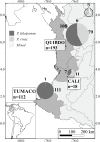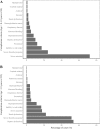Complicated malaria in children and adults from three settings of the Colombian Pacific Coast: A prospective study
- PMID: 28945797
- PMCID: PMC5612730
- DOI: 10.1371/journal.pone.0185435
Complicated malaria in children and adults from three settings of the Colombian Pacific Coast: A prospective study
Abstract
Background: Complicated malaria remains an important public health problem, particularly in endemic settings where access to health services is limited and consequently malaria fatal outcomes occur. Few publications describing the clinical course and outcomes of complicated malaria in Latin America are found in the literature. This prospective study approached the clinical and laboratory characteristics of hospitalized patients with complicated malaria in different endemic areas of the Colombian Pacific Coast with the aim to provide epidemiological knowledge and guide to further reducing malaria severity and mortality.
Methods and findings: A prospective, descriptive hospital-based study was conducted in 323 complicated malaria patients (median age 20 years) enrolled in Quibdó, Tumaco and Cali between 2014 and 2016. Clinical evaluation was performed and laboratory parameters were assessed during hospitalization. Plasmodium falciparum was the most common parasite species (70%), followed by P. vivax (28%), and mixed malaria (Pf/Pv; 1.9%). Overall, predominant laboratory complications were severe thrombocytopenia (43%), hepatic dysfunction (40%), and severe anaemia (34%). Severe thrombocytopenia was more common in adults (52%) regardless of parasite species. Severe anaemia was the most frequent complication in children ≤10 years (72%) and was most commonly related to P. vivax infection (p < 0.001); whereas liver dysfunction was more frequent in older patients (54%) with P. falciparum (p < 0.001). Two deaths due to P. vivax and P. falciparum each were registered. Treatment provision before recruitment hindered qPCR confirmation of parasite species in some cases.
Conclusions: The study identified a high prevalence of complicated malaria in the Pacific Coast, together with more frequent severe anaemia in children infected by P. vivax and hepatic dysfunction in adults with P. falciparum. Results indicated the need for earlier diagnosis and treatment to prevent complications development as well as more effective attention at hospital level, in order to rapidly identify and appropriately treat these severe clinical conditions. The study describes epidemiological profiles of the study region and identified the most common complications on which clinicians must focus on to prevent mortality.
Conflict of interest statement
Figures





References
-
- WHO (2016) World Malaria Report 2016. Geneva: World Health Organization. 186 p.
-
- PAHO/WHO (2017) Epidemiological Alert Increase in cases of malaria http://www.paho.org: The Pan American Health Organization.
-
- WHO (2016) World Malaria Report 2016. Geneva: World Health Organization.
-
- Arevalo-Herrera M, Lopez-Perez M, Medina L, Moreno A, Gutierrez JB, Herrera S (2015) Clinical profile of Plasmodium falciparum and Plasmodium vivax infections in low and unstable malaria transmission settings of Colombia. Malar J 14: 154 doi: 10.1186/s12936-015-0678-3 - DOI - PMC - PubMed
-
- Wassmer SC, Taylor TE, Rathod PK, Mishra SK, Mohanty S, Arevalo-Herrera M, et al. (2015) Investigating the Pathogenesis of Severe Malaria: A Multidisciplinary and Cross-Geographical Approach. Am J Trop Med Hyg 93: 42–56. doi: 10.4269/ajtmh.14-0841 - DOI - PMC - PubMed
MeSH terms
Grants and funding
LinkOut - more resources
Full Text Sources
Other Literature Sources

